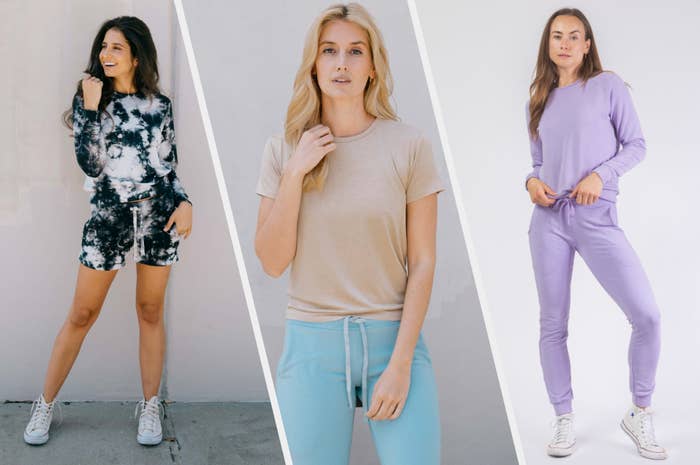The Significance of Lasting Clothes: How It Influences the Setting and Your Closet
Sustainable apparel is increasingly acknowledged for its essential duty in decreasing the ecological influence of the fast apparel industry. By concentrating on eco-friendly products and honest production methods, it resolves pressing ecological worries. This shift not just profits the planet yet additionally affects customer selections, bring about an extra thoughtful approach to wardrobe monitoring. Recognizing these characteristics increases crucial questions concerning style's future and personal duty in shaping it.
The Environmental Footprint of Quick Style

Advantages of Sustainable Materials
Lasting materials supply substantial advantages, specifically via green material choices that minimize environmental harm. These materials also demonstrate longevity and longevity, decreasing the need for frequent substitutes. As an outcome, they contribute to a much more sustainable style market and advertise accountable customer actions.
Eco-Friendly Fabric Selections
While the style market has long been connected with fast trends and ecological damage, the surge of green fabric options offers a transformative possibility. Sustainable products such as organic cotton, hemp, and Tencel have actually obtained appeal as a result of their lower ecological impact. These fabrics are typically generated without hazardous pesticides and call for much less water, decreasing their carbon impact - Branded Clothing. In addition, many environment-friendly textiles are naturally degradable, contributing to a circular economic situation by reducing waste. Choosing sustainable products not only sustains eco responsible techniques yet also promotes much healthier communities. As customers end up being much more aware of their buying power, the need for environment-friendly fabrics encourages brands to innovate and embrace even more sustainable manufacturing techniques, eventually profiting the earth and future generations
Toughness and Durability Advantages
Several consumers are progressively acknowledging the sturdiness and longevity benefits of lasting materials in their garments options. Unlike conventional textiles, sustainable products such as natural cotton, hemp, and recycled polyester are crafted to withstand wear and tear, resulting in garments that last longer. This decreased regularity of substitute not just conserves consumers money in time but also lessens waste created by fast fashion. Additionally, sustainable apparel commonly uses environment-friendly manufacturing methods that boost fabric toughness, contributing to a reduction in the general carbon footprint. By buying long lasting garments, customers can grow a more lasting wardrobe while appreciating high-quality pieces that maintain their aesthetic and functionality gradually. Subsequently, durability and longevity stand as crucial benefits of selecting lasting materials.
Decreasing Waste Through Sustainable Practices
Lowering waste in the garment industry can be accomplished with innovative methods such as upcycling and repurposing products. In addition, embracing minimal closet techniques urges consumers to prioritize quality over amount, eventually reducing clothing consumption. Together, these approaches contribute considerably to a more sustainable clothes model.
Upcycling and Repurposing Materials
Upcycling and repurposing products have emerged as cutting-edge methods in the fashion market, transforming disposed of fabrics right into valuable new items. This strategy not only decreases waste however also encourages creative thinking and individuality in clothes design. By taking old garments and materials, designers can create one-of-a-kind items that show personal style while lowering the demand for new sources. In addition, upcycling frequently requires less energy and water contrasted to traditional manufacturing procedures, greatly lowering the environmental impact of style. As customers become more knowledgeable about sustainability, the appeal of upcycled apparel continues to increase, advertising a round economy. Ultimately, these practices add to a much more lasting future, where style prioritizes environmental health over quick manufacturing and usage.

Minimalist Wardrobe Approaches
As individuals increasingly look for to reduce their environmental influence, embracing minimal closet techniques has gained grip as an efficient method to sustainable fashion. These approaches stress quality over amount, motivating customers to curate a smaller sized collection of versatile, long lasting apparel. By concentrating on timeless pieces that can be blended and matched, people can reduce the frequency of acquisitions and ultimately lower waste.Additionally, minimalism promotes mindful consumption, prompting buyers to mirror on the honest and environmental ramifications of their options. This strategy not just cultivates a more lasting way of life but also simplifies day-to-day decision-making relating to clothing. As people welcome minimalist principles, they contribute to a style society that values sustainability and liable consumerism, ultimately leading to a much more eco-conscious culture.
The Role of Honest Labor in Sustainable Style
While lots of customers are progressively knowledgeable about the ecological repercussions of their apparel selections, the relevance of ethical labor techniques in sustainable fashion can not be overlooked. Ethical labor incorporates reasonable incomes, secure working conditions, and regard for workers' civil liberties, developing the backbone of responsible fashion production. Brand names that prioritize ethical labor not just boost neighborhoods yet additionally set a standard for accountability in the industry.Moreover, the integration of ethical methods cultivates transparency, enabling consumers to make educated choices concerning their acquisitions. This technique contrasts check my blog greatly with fast fashion's exploitative labor models, which usually focus on earnings over individuals. By supporting business committed to moral labor, customers contribute to a system that values human self-respect together with environmental sustainability. Subsequently, moral labor is not just an add-on; it is vital to the more comprehensive mission of sustainable fashion, ensuring that the pursuit for eco-friendliness does not come with the expenditure of civils rights.
The Impact of Lasting Garments on Carbon Emissions
Lasting clothes has the possible to significantly decrease carbon discharges related to the fashion sector. Traditional garment manufacturing adds significantly to greenhouse gas discharges, mostly as a result of energy-intensive production processes and using non-renewable resources. On the other hand, sustainable style focuses on green products, such as natural cotton or recycled fibers, which frequently require much less power to produce.Moreover, lasting brands have a tendency to embrace a lot more efficient production methods, decreasing waste and decreasing general emissions. By focusing on sturdiness and timeless layout, lasting apparel motivates consumers to buy much less often, further lowering the carbon footprint related to overconsumption.Additionally, numerous sustainable brands are devoted to transparency in their supply chains, allowing customers to make educated selections that straighten with their worths. Inevitably, moving in the direction of sustainable garments can cause a substantial reduction in carbon discharges, contributing to a healthier world and a much more lasting future for the style market.
Sustaining Regional Economies With Lasting Options
The shift towards sustainable clothes not only addresses environmental worries yet additionally substantially advantages local economic climates. By picking sustainable fashion, consumers usually sustain neighborhood craftsmens and local business, enhancing area strength. These enterprises commonly operate a smaller scale, prioritizing craftsmanship and honest techniques over mass production.Investing in locally made sustainable garments cultivates work creation and stimulates economic growth within areas. As customers end up being a lot more knowledgeable about the environmental influence read this of their acquisitions, they significantly choose items that mirror their values. This need encourages local suppliers to embrace sustainable methods, adding to a round economy.Moreover, supporting local companies reduces transportation exhausts, aligning with eco-conscious customer behavior. The interconnectedness of lasting garments and neighborhood economic climates underscores the crucial function that individual selections play in advertising both economic and environmental health and wellness. By promoting these neighborhood connections, areas can prosper while likewise working in the direction of a much more sustainable future.
Changing Your Storage Room: Tips for a Lasting Closet
As individuals look for to decrease their environmental influence, transforming a wardrobe right into a sustainable closet comes to be an important action. One reliable strategy is to evaluate existing clothing, keeping only products that are worn frequently and that straighten with sustainability goals. Prioritizing high quality over quantity is important; investing in sturdy items from green brand names can considerably reduce waste.Additionally, including used things can take a breath new life into a closet while minimizing environmental damage. Organizing garments swaps with good friends or donating unused items can additionally promote sustainability.When shopping, individuals need to look for materials that are organic, recycled, or biodegradable, and stay clear of quick style stores - Branded Clothing. Finally, practicing conscious consumption by attentively considering each acquisition can contribute to a much more sustainable lifestyle. By carrying out these suggestions, one can create a wardrobe that mirrors personal design while sustaining environmental stewardship
Often Asked Concerns
Exactly How Can I Determine Sustainable Garments Brands?
To identify lasting garments brand names, one need to investigate materials used, look for qualifications like Fair Profession, and take a look at the brand's transparency regarding their manufacturing procedures, labor techniques, and ecological impact, making certain environmentally friendly and moral techniques are prioritized.
What Are the Prices Connected With Sustainable Style?
The expenses related to sustainable style can differ significantly. Greater manufacturing expenditures, ethical sourcing, and green products often lead to boosted list prices, which may deter some consumers while interesting eco aware consumers.
Can Lasting Clothes Be Trendy and Trendy?
Lasting clothing can indeed be fashionable and fashionable. Designers progressively prioritize cutting-edge products and ethical production techniques, showing that fashion and sustainability can exist together. Consumers now have diverse options that blend aesthetics with ecological awareness.
Exactly How Does Washing Garments Affect Their Sustainability?
Washing clothes significantly impacts sustainability by consuming water and power, adding to pollution, and creating microplastic launch. Regular cleaning can break down materials, reducing their lifespan and boosting the demand for substitutes, ultimately exacerbating environmental concerns.
What Is the Life Expectancy of Lasting Clothes Compared to Fast Fashion?
The life-span of sustainable garments usually exceeds that of fast style items, frequently lasting numerous years as a result of top quality products and craftsmanship. On the other hand, fast style garments might weaken promptly, requiring even more frequent replacements. Sustainable clothing is progressively recognized for its essential duty in reducing the ecological impact of the quick fashion market. While numerous customers are significantly aware of the ecological effects of their apparel selections, the significance of moral labor techniques in sustainable style can not be overlooked. Branded Clothing. Sustainable apparel has the possible to substantially reduce carbon discharges linked with the style industry. In comparison, lasting fashion concentrates on environmentally friendly products, such as organic cotton or recycled fibers, which commonly require less energy to produce.Moreover, lasting brands tend to take on a lot more efficient manufacturing methods, decreasing waste and lowering general emissions. read the full info here By focusing on toughness and classic layout, lasting apparel urges consumers to buy less often, additional lowering the carbon footprint associated with overconsumption.Additionally, many lasting brands are devoted to transparency in their supply chains, making it possible for customers to make educated options that line up with their values